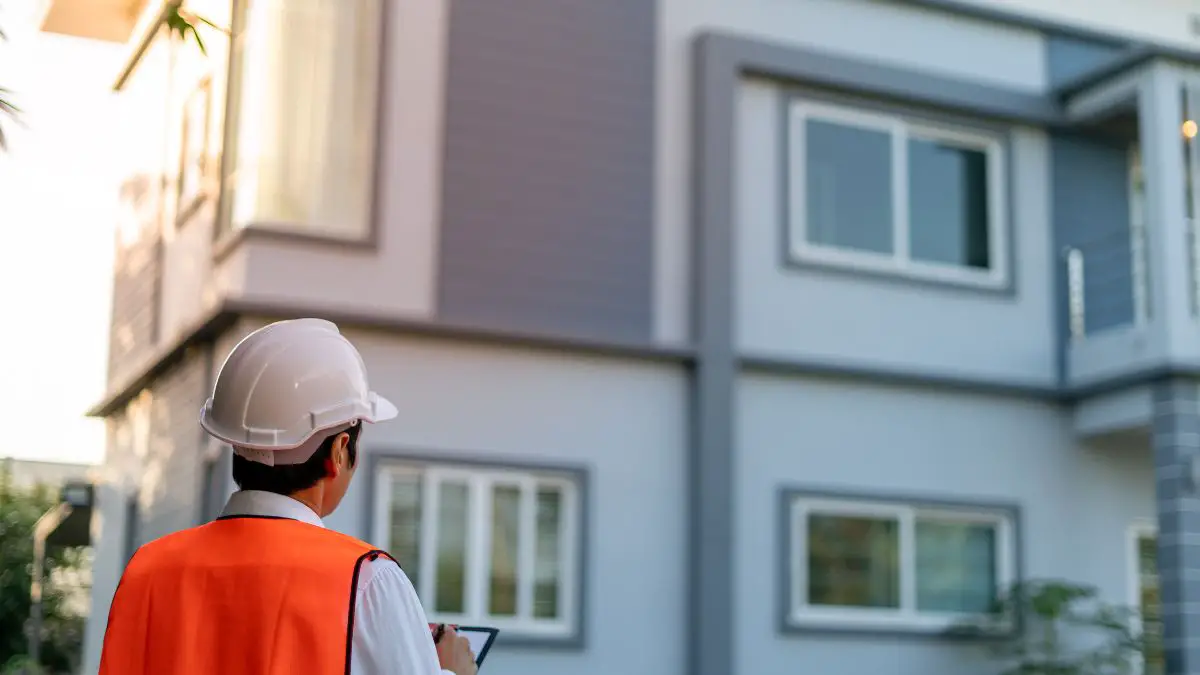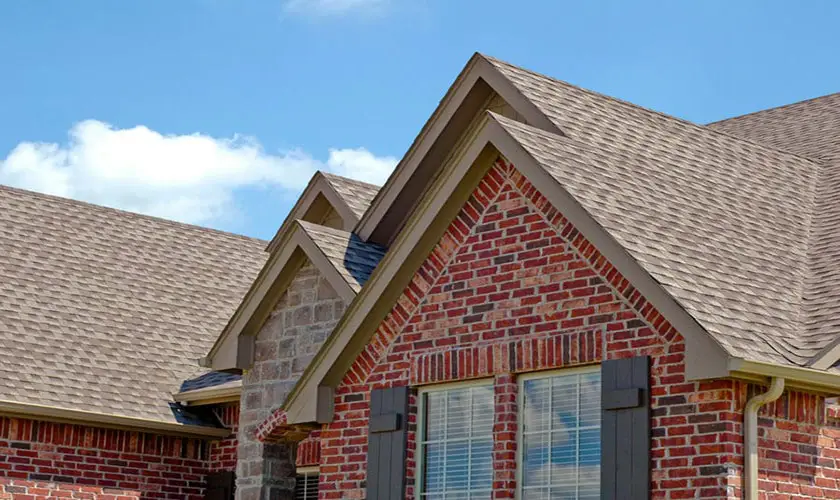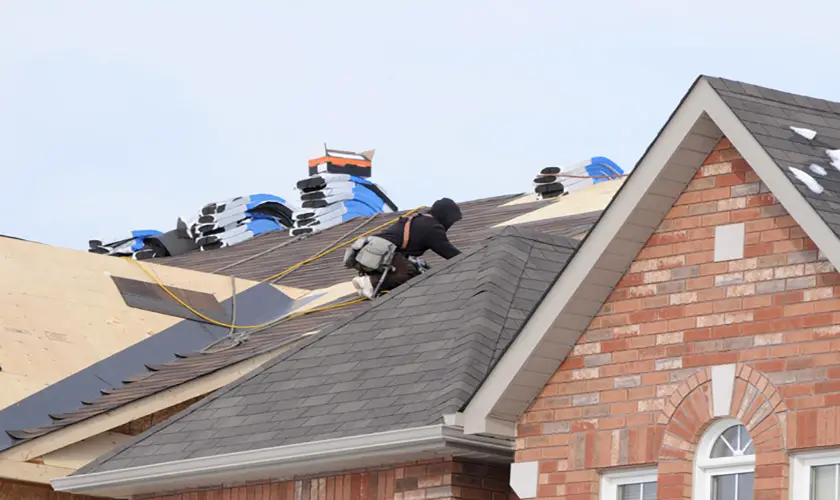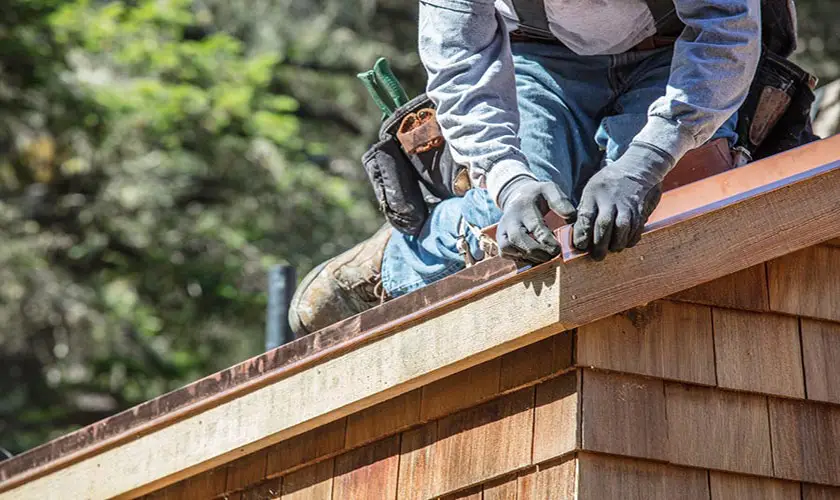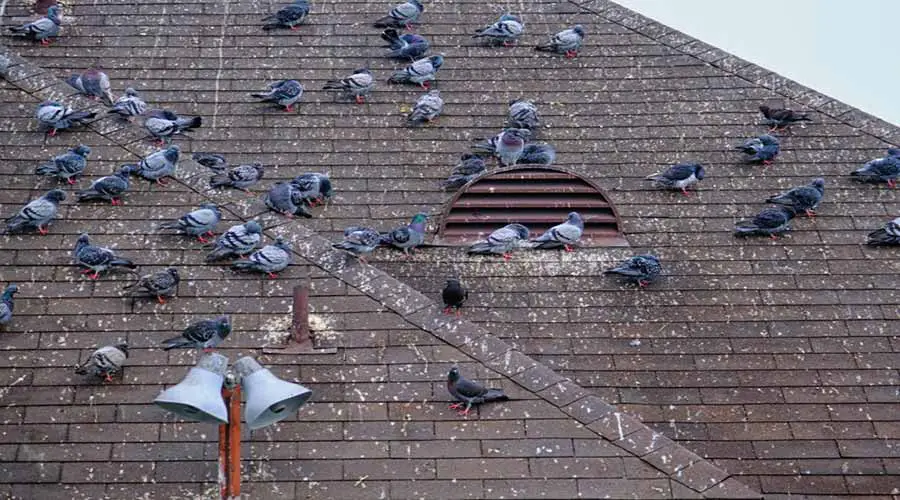People have different ideas of what they think a steep roof pitch is. But OSHA states that a steep roof has a rise-to-run ratio of 4:12 or more and an angle of at least 18.43°.
Thus, any roof pitch with a rise-to-run ratio lower than 4:12 results in low-sloped roofs. But, some types of architectural designs call for a dramatic pitched roof. In such cases, the roof slope is steeper than usual. And that applies to anything with a rise-to-run ratio of 12:12 and an angle of 45° or more.
To choose a steep roof, understand factors like roof pitch and rise-to-run ratios and weigh pros and cons. This article discusses all these things in detail to help you determine how steep your roof should be.
How Do You Measure Roof Pitch?
Any roof pitch with an angle of 18.43° or a rise-to-run ratio of 4:12 or more qualifies as a steep roof. But what does it all mean?
A roof pitch refers to how steep it is. The slope is measured in the ratio of inches rise per horizontal foot (or the metric equal). You can also refer to the pitch as a roof’s vertical rise over a horizontal run/span.
So long as a roof is not flat, it also forms an angle of deviation from the horizontal plane. So a ratio of 4:12, which is the beginning point for steep roofs, means the roof rises 4 inches per 12 inches span. And that translates into the 18.43° threshold.
We measure roof pitches as vertical rise over a horizontal run, where the run always equals 12” (12 inches). The number 12 comes into play because 12 inches make up one foot.
So, a roof with a 6/12 slope is a steep roof (26.57 °). But, one with a pitch of 8/12 (33.69 °) is more vertical. A roof with a 10/12 slope (39.81 °) is the steepest of the three. And any roof with 12:12 (45 °) pitch has entered the dramatic pitched-roof territory.
It is also worth noting that while flat roofs seem completely horizontal, they may not always be. Some flat roofs have a small pitch of 0.25:12 for drainage purposes. But, others have a slope of 0/12, translating to 0° or 180°.
Factors That Determine a Roof’s Steepness
There is nothing wrong with wanting a steep roof. However, several factors influence how steep your roof slope should be. Below are some critical things to consider when choosing a roof slope.
1. Your Geographical Region
Where you live will determine how steep your roof will be due to the area’s climate. In places with lots of snow, wind, and rain, steep roofs help drain away precipitation, protecting them.
For example, in cold and temperate climates of Northern Europe and America, you will notice plenty of steep gabled roofs. These roofs have steep pitches to help drain the snow or rain that hits the rooftop.
If your area has drainage problems, a steeper roof pitch might be a good idea. But bear in mind that some types of steep roofs may need support against strong winds.
2. Local Building Codes
Your local building codes have a role to play in determining how steep the roof pitch is for high-sloped roofs. When you build, consider your climate, architectural design, and roofing materials. These factors affect building codes.
In snowy climates cities like New York or Chicago, experts suggest using steeper roofs for better performance.
In dry places like the Arizona desert, roofs that are flat or have a low-slope roof work well because it rains less.
3. Architectural Property Design
The architectural property design you prefer will influence your roof pitch to a significant degree. That’s because roof shapes and slope roof designs partly define some types of architecture.
Generally, Elizabethan and Gothic house designs tend to offer drama. Elizabethan homes have longer rafters than the span, creating a dramatic pitched roof with angles over 45°.
Very steep gable roofs also define Tudor homes. It is common to find rooftops with pitches of anywhere from 10:12 to 14:12 on such properties.
But, Gothic architectural designs have a rise in inches usually equal to the run (e.g., 12:12), thus putting their roof pitches at 45°.
Some Roman homes are also steep. The general rule of thumb is to have rafter lengths that are one-third of the span. So, they can meet the 4:12 steep roof pitch threshold. But, some fall below that.
4. Your Building and Renovation Budget
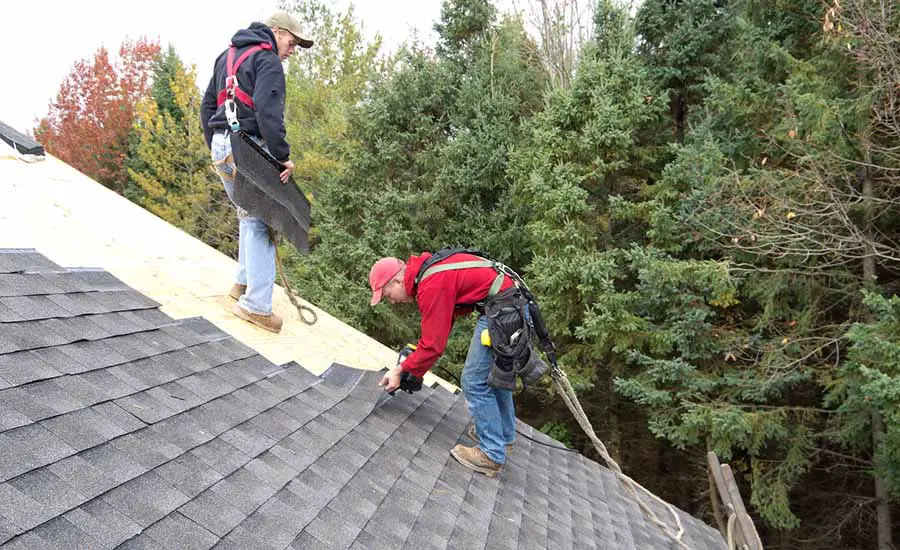
The steeper you want your roof to be, the more money you should prepare to pay to build and renovate it.
The steeper the roof, the more safety measures you need to take to safeguard anyone who installs or replaces it. Some safety systems are guardrails with toe boards, personal fall arrest systems, and safety nets.
Workers must take these measures on steep roofs because the more significant incline roof angle makes it harder to work on. And they are more likely to fall and injure themselves. Also, their tools and debris will likely slide from the roof and harm those beneath.
But, putting those safety measures in place tends to come at a price. Whether putting on a new roof or fixing it up, it’ll cost you more.
And that’s not the only challenge. Most times, the construction contractors must put their roofing components together on the ground. Installing a bundle of asphalt shingles can be challenging on a small roof surface. And the steep incline makes it harder to carry many things at once because it requires extra endurance.
Because of the difficulties with logistics, you might have to spend more money on safety equipment and labor for roofing. Contractors will also take longer to complete their work. Again, you will be the one paying for everything.
For these reasons, steep roofs are more expensive than flat or low-sloped roofs. So, it would help if you had enough money to accommodate the issues that will come up during installation or repair.
5. Your Preferred Roofing Materials
You can use various roofing materials on a steep slope. But others are much more suitable for low-sloped or flat roofs.
Your biggest obstacle will be your local building codes and what they state about the roofing material you want to install. If you do not stick to the regulations, you may pay for that in the future. If you want to use a specific roofing material, you might need to adjust the angle of your roof, add more extra materials, or choose a less preferred option.
Roofs can be made of wood, sheet metal, slate, concrete, clay tiles, asphalt, wood shake, shingle systems, or mineral-surfaced roofing. You can install them on roofs with slopes of 4:12 or more.
Some roofs may need a double synthetic underlayment to work better. Some roofing materials, such as EPDM and TPO membranes, should not be used on steep roofs. So, you cannot use them on a steep roof.
The texture of your roofing materials also matters. Metal tiles are great for low-sloped roofs because precipitation slides off them.
If you choose a steep roof with an average pitch of 4:12 to 6:12, smooth rooftops can cause problems in areas with heavy rainfall. When it snows a lot, you should use roofing materials with texture. This helps the roof hold the snow and prevents accidents.
To improve safety during heavy snow, design your roof to prevent shedding in busy areas if the pitch is over 6:12. The last thing you want is for your loved one to die in a snow avalanche generated by your roof.
6. The Roof’s Functionality
It would be best to consider the functionality of your roof before you settle on its steepness. The lower the roof slope, the easier it is to install something that lies on the surface for a prolonged period.
For example, if you want to install solar panels, you would be better off with a low-sloped or flat roof. You can install and maintain such panels. And if you want to take advantage of sunlight coming from a particular direction, you can have the panels tilted.
But, solar panels perform best when tilted at angles of 30°or more. And steeper roofs with pitches higher than 40° are less than ideal for solar panels.
So, while you could get some sunlight from one direction, the steeper roof sections may block sun rays from the opposite direction as the day passes. When that happens, your solar panels will not store as much energy as they should and, thus, perform.
Also, it is much harder to install and maintain solar panels on a steeper roof because it has to defy the force of gravity. Also, your panels may not get the best sunrays. And you may need more equipment and resources to keep the panels in place.
But, while solar panels may not suit dramatic pitched roofs, they could work well for water harvesting. They tend to shed water and reduce the likelihood of it becoming contaminated, unlike flatter roofs. So, you will end up with cleaner water much faster, even if the rainfall amounts are low.
7. The Manufacturer’s Warranty
Roofs have a warranty of about 20 years. Contractors will fix them for free or at a lower price. But your ability to enjoy the warranty depends on whether you followed the installation instructions to the letter.
Many manufacturers specify the smallest roof pitch for their products. Remember, their threshold may exceed your building codes’ smallest roof slope requirements.
Suppose you do not follow the steepness guidelines. If you do that, your roofing warranty will be voided. Then, you’ll be responsible for any roofing problems, even before the warranty is up.
Pros and Cons of a Steep Roof Pitch
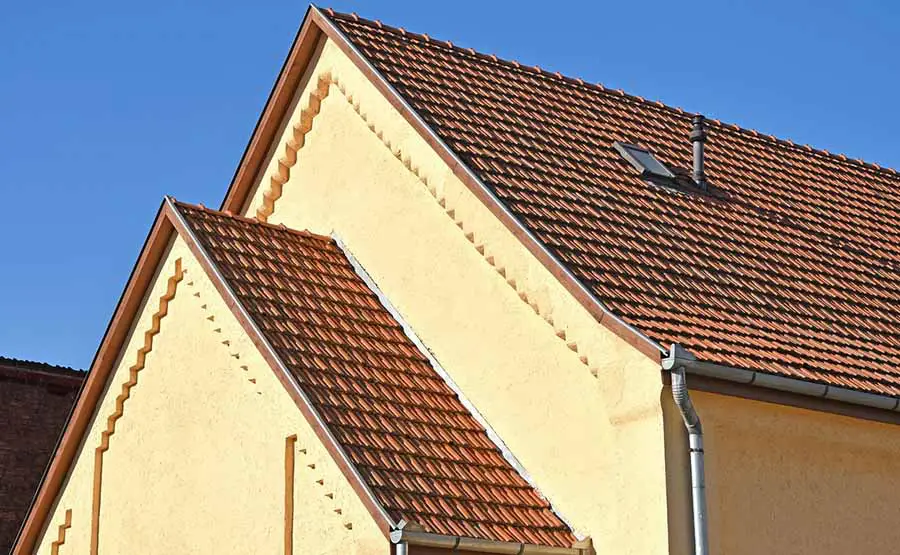
Steep roof pitches have their fair share of pros and cons. Below are some of them.
Pros of Steep Roofs
The following are some of the advantages of installing steep roofs on your home:
- Steep roofs shed water, making them great for water harvesting and reducing your bills.
- Roofs with steep pitches drain well, which reduces water damage to their surface, thus extending their lifespan. In addition, they will require less maintenance.
- The steeper the roof, the more space it creates underneath, extending your usable space in the home.
- Steep roofs can withstand strong winds and the elements pretty well, allowing them to withstand Mother Nature’s wrath.
- The attic space underneath steep roofs provides improved ventilation and reduces energy costs in your home.
- Steep roofs can be a way to make a dramatic impression on people because they are apparent and remarkable.
Cons of Steep Roofs
While steep roofs offer many benefits, they also have some disadvantages worth remembering.
- It is much harder to install or renovate steep roofs. They pose a danger to your safety or that of your contractors.
- Due to the logistical challenges of dealing with roofs with steep pitches, you will spend more installing or repairing them.
- On a steeper roof, you would have less utility space to do other things, such as creating additional outdoor space on the rooftop.
- When steep slopes shed debris, it falls on the gutter system or the ground. So, you will have to clean your gutters or lawn regularly.
When Should You Opt For a Steep Roof Pitch?
Some circumstances need you to focus on a steep roof pitch over a flat or low-sloped roof.
If you want a striking house, it’s best to choose a steep roof pitch. This helps with water drainage and minimizes roof damage. Also, consider a sloped roof if you opted for architectural designs that call for a higher rise-to-run ratio, like Tudor designs. Also, you could focus on a steep roof pitch if you have a big budget for your roof and do not mind the work that goes into providing the drama.
Steep roofs also come in handy if you want to maintain your warranty as long as possible or require additional space for storage or other things.
FAQS about Steep Roof Pitch
What is the pitch of a steep roof?
The pitch of a steep roof has a rise-to-run ratio of 4:12 or greater. This means for every 12 inches (or one foot) of horizontal run, the roof rises 4 inches. But pitches of 6:12 or even greater are common for steep roofs, with some going as steep as 12:12, which equates to a 45-degree angle.
Is 8 12-pitch a steep roof?
Yes, an 8:12 pitch is considered a steep roof. This means the roof rises 8 inches for every 12 inches horizontal run. Roofs with pitches of 4:12 or higher are generally classified as steep slope roofs, so an 8:12 pitch well exceeds this smallest standard.
Is 45 degrees a steep roof?
Yes, a 45-degree roof pitch is considered very steep. In roofing terms, this corresponds to a 12:12 pitch, where the roof rises 12 inches for every 12 inches of horizontal run. This angle is usually seen on fancy roofs with traditional or dramatic styles.
Is a 7-12 roof pitch steep?
Yes, a 7:12 roof pitch is considered to be steep. While the threshold for a steep roof starts at a 4:12 pitch, a 7:12 pitch means the roof rises 7 inches for every 12 inches of horizontal run, steeper than the minimum slope. The angle of the roof affects how it looks and how it’s built and maintained. It also affects how snow and water flow off the roof.
Final Thoughts
Both low-sloped and steep roofs have their place. But, steeper pitch roofs tend to offer many aesthetic and functional benefits worth considering. It would be best to select a steep roof, depending on your preferences and how practical it is for your property.
If you have an adequate budget, you can get one of the steepest roofs around. And if nothing else, it will likely make a lasting first impression on everyone who sees your home. It is unlikely that you would ever have to worry too much about curb appeal.



